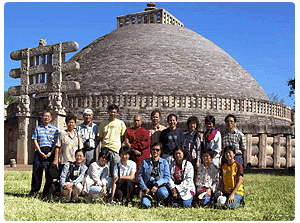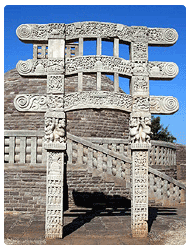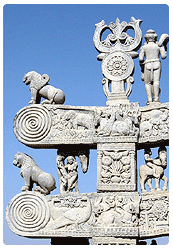 Buddhist pilgrims at the
main Sanchi stupa.
Buddhist pilgrims at the
main Sanchi stupa. |
The Hill
of Sanchi is situated about nine kilometers southwest of
Vidisha in Madhaya Pradesh, India. Crowning
the hilltop of Sanchi nearly ninty-one metres in height,
a group of Buddhist monuments commands a grand view even
from a distance. It is unique not only in its having the
most perfect and well-preserved stupas but also in its offering
a wide and educative field for the study of the genesis,
efflorescence and decay of Buddhist art and architecture
for a period of about thirteen hundred years, from the third
century B.C. to the twelfth century, A.D., almost covering
the whole range of Indian Buddhism. This is rather surprising,
for Sanchi was not hallowed by any incident in Buddha's
life; not is it known to have been the focus of any significant
event in the history of Buddhist monachism. Hiuen Tsang,
who so meticulously recorded the details connected with
Buddhist monuments, is silent about it. The only possible
reference to it is contained in the chronicles of Sri Lanka,
according to which Mahendra, son of Asoka and his queen
Devi, daughter of a merchant of Vidisa, (modern Besnagar
near Bhilsa or Vidisha) whom Asoka had married during his
halt there on his way to Ujjayani as a viceroy, is said
to have visited his mother at Vidisa, and the latter took
him up to the beautiful monastery of Vedisagiri built by
herself. Mahendra had stayed there for a month before he
set out for Sri Lanka.
The
foundation of the great religious establishment at Sanchi
destined to have a glorious career as an important centre
of Buddhism for many centuries to come, was probably laid
by the great Maurya emperor Asoka (circa 273-236 B.C.),
when he built a stupa and erected a monolithic pillar
here. In addition to his marriage with a lady of Vidisa,
the reason for his selection of this particular spot may
be due to the fact that the hilltop served as an ideal
place for giving a concrete shape to the newly aroused
zeal for Buddhism in the emperor, who is said to have
opened up seven out of the eight original stupas erected
over the body relics of Buddha and to have distributed
the relics among innumerable stupas built by himself all
over his empire. By its quietude and seclusion ensuring
a proper atmosphere for meditation, combined with its
proximity to the rich and populous city of Vidisa, Sanchi
fulfilled all the conditions required for an ideal Buddhist
monastic life. The dedicatory inscriptions at Sanchi unmistakably
show that the prosperity of the Buddhist establishment
here was, to a great extent, due to the piety of the rich
mercantile community of Vidisa. The nearness of the city,
the strategic situation of which - at the confluence of
two rivers, the Betwa and the Bes, as well as on two important
trade routes resulted in a great overflow of wealth, was
in no small measure responsible for the flourishing condition
of Sanchi even when the empire of the Mauryas was a thing
of the past.
After
a temporary setback following the breakup of the Maurya
empire, when the stupa of Asoka was damaged, the cause
of the Buddhist establishment of Kakanaya was taken up
with a feverish zeal by the monks and the laity alike,
not a negligible percentage of the latter being formed
by visitors of Vidisa for trade and other purposes. The
religious fervour found its expression in vigorous building
activity about the middle of the second century B.C.,
during which the Sungas were ruling and which saw the
stone encasing and enlargement of the stupa of Asoka,
the erection of balustrades round its ground, berm, stairway
and harmika, the reconstruction of Temple 40 and the building
of Stupas 2 and 3. The same intense religious aspiration
and creative forces continued unabated in the next century
as well, when, during the supremacy of the Satavahanas,
new embellishments, in the form of elaborately-carved
gateways, were added to the stupas.

Gateway of Stupa 3,
Sanchi.
|
The
political vicissitude which northern India went through
immediately before and after the Christian era, when the
Scytho-Parthians and Kushans invaded and annexed a large
part of the land, had perhaps its repercussions at Sanchi
as well, resulting in a slackening of structural activities.
The establishment of a foreign power in the Malwa region
under the Kshatrapas, engaged in chronic warfare, hardly
provided any incentive for the dormant workshop. However,
like the contemporary Buddhist centres of north and southeast
India, Sanchi freed itself, during the period, from the
earlier aniconic tradition, but its contribution to the
evolution of the image of Buddha was nil, and it depended
for such images on imports from Mathura.
After
a prolonged period of stagnation and lassitude under the
Kashtrapas, there was a revival of sculptural activity
at Sanchi during the reign of the Guptas who, after conquering
the Kshatrapas (circa A.D. 400), provided peace and prosperity
essential for the growth of artistic pursuits. The discovery
a few images in Mathura, sandstone executed in the early
Gupta tradition, proves that Mathura continued, even in
the fourth century A.D., to meet the demand of the clientele
of Sanchi. But soon afterwards the local art of Sanchi
once more came to the fore, and to this period belong
the four images of Buddha seated under canopies against
the berm of Stupa 1 facing the four entrances. But even
in the best days of the Guptas the figures of Buddha from
the ateliers of Sanchi fell short, in standard and number
of their counterparts at such Buddhist centres as Sarnath.
The
Gupta period, which ushered in a new epoch in the history
of Indian temple-architecture, saw at Sanchi as well as
resuscitation of structural activity. In Temple 17, which
has withstood the ravages of time, we find one of the
earliest Gupta temples noted for their well-balanced proportion,
restraint in ornamentation and elegance.
After
the glorious days of the Guptas centrifugal forces became
once more rampant. And then came the shock of the Hana
invasions, which resulted in the seizure of a large part
of western and central India by that tribe. But that occupation
was short lived, to be shattered by Yasodharman's victory
over their chief Mihirakula in the first half of the sixth
century.
On
the ashes of the Gupta empire rose a number of small kingdoms,
none of which was powerful enough to bring any large part
of India under its aegis, till Harshavardhana (A.D. 606-647)
achieved some sort of political unity in northern India.
His espousal of the cause of Buddhism brought a fresh
lease of life to that religion. The vestiges of the seventh
and eighth centuries, which saw at Sanchi the building
of several monasteries and temples, reveal a prosperous
condition of the Buddhist community at the place. The
number of the images of Buddha made during the period
was fairly considerable; executed in late Gupta tradition,
they, however, lack the charm and grace of their prototypes
and are almost lifeless and mechanical.
After
the death of Harsha, northern India once, more became
a prey to the ambitions of different dynasties. The Pratiharas,
who had established themselves in the Malwa region by
the eighth century, were followed by the Paramaras in
the next century. But Sanchi seems to have been hardly
affected by these political changes, as the existence
of a number of medieval monasteries and temples testifies
to a period of continued prosperity. Temple 45, for example,
which is now a mere shell bereft of its original splendour,
has the same architectural pompousness and exuberance
of decoration as would characterise the contemporaneous
north Indian architecture. From the find of such images
like Vajrasattva and Marichi, it is abundantly clear that
Vajrayana did extend its roots here as well.
It
is not known how the end came to the Buddhist establishment
at Sanchi. No Buddhist monument can be assigned to the
thirteenth century A.D. on the other hand, to this period
belong a number of Brahmanical plaques containing representations
of Vishnu, Ganega, Mahishasuramardini, etc. We do not
know if the Buddhists deserted the place or gradually
lost their vital forces to maintain their individuality
thus succumbing to the all absorbing force of Brahmanism,
which was one of the potent causes of the extinction of
Buddhism in the land of its birth.


Detail of North Gateway. |
The
relics of Sariputra and Maha Moggalana, the two foremost
disciples of the Buddha, were found by Colonel Cunningham
in 1851 in this stupa, enshrined at the centre of at the
centre of the dome on the level of the terrace.
From
the fourteenth century onwards, Sanchi was left deserted
and unnoticed, till in the year 1818 General Taylor brought
it to public attention by discovering its ruins, of which
he found Supas 1, 2 and 3 intact. The great interest which
this discovery created accounts to a large extent for
the immense damages suffered by the monuments at the hands
of amateur archaeologists and treasure-hunters. In 1822,
Captain Johnson, Assistant Political Agent in Bhopal,
opened up Stupa 1 from top to bottom on one side, thus
leaving a great breach which resulted in the collapse
of the. West Gateway and a part of the enclosing balustrade.
Stupa 2 was also partially destroyed. Alexander Cunningham,
together with Captain F. C. Maisey, excavated Stupas 2
and 3 in 1851 and found relic caskets within. They also
sank a shaft at the centre of Stupa 1, which, however,
failed to yield any relies. These operations coupled with
the depredations of villagers and the growth of vegetation,
wrought havoc to the stupas. The pillar of Asoka was broken
into pieces by a local zemindar to be utilized as a sugarcane
press.
The
question of repairs and preservation was not considered
till 1881, when Major Cole took up the work in earnest
and succeeded, in the course of the next three years,
in clearing off vegetation, filling in the breach in the
dome of Stupa 1, setting up its fallen West and South
Gateways and a part of its railing and restoring the gateway
in front of Stupa V. The other monuments, however, were
left uncared for and no attempt was made to expose the
structures lying buried under debris. This work was later
on undertaken creditably by Sir John Marshall, Director
General of Archaeology in India, who, between the years
1912 and 1919, brought the monuments to their present
condition. His work entailed a large-scale clearance of
jungle, excavation and thorough conservation of the edifices,
which included the complete dismantling and rebuilding
of the southwest quadrant of Stupa 1, setting up of its
balustrades and erection of the crowning members, reconstruction
of the dome, balustrade and crowning members of Stupa
3, resetting of the out-of-plumb pillars of Temple 18
repairs to the perilously decayed Temple 45, rebuilding
of the retaining wall between the Main Terrace and Eastern
Area, re-roofing and repairs of Temples 17, 31 and 32
and provision of an effective drainage. The site was next
turfed and planted with trees and flowering creepers.
A small museum was also built to house the loose antiquities
found in the course of these operations.
In 1936, Mohammad Hamid excavated the ruins on the hill-slope
between Stupas 1 and 2 and brought to light the well-preserved
shell of a monastery. Since then, though no excavation
has been done, the monuments have received persistent
attention and have been saved for posterity.
|
 |
